Submitted:
07 September 2023
Posted:
11 September 2023
You are already at the latest version
Abstract
Keywords:
1. Introduction
2. Methods
2.1. Chemicals and reagents
2.2. Hapten synthesis
2.3. Preparation of coating antigens
2.4. Indirect competitive enzyme-linked immunosorbent assay (icELISA)
2.5. HRP-labelled antigen preparation
2.6. Immunosorbent preparation
2.7. Direct competitive assay formats
2.8. Sample pretreatment and analysis
3. Results and discussion
3.1. Synthesis of haptens
3.2. Preparation of conjugated antigens
3.3. Specificity and sensitivity of the developed ELISA variants
3.4. Direct competitive assay formats
3.5. Effect of sample volume increase on sensitivity in plate assay format
3.6. Effect of oriented coating of antibody and competitive stage duration on assay sensitivity
3.7. Effect of sample volume increase on sensitivity assessed in IBA and IFA
3.8. Environmental water analysis and recovery examination
4. Conclusions
Supplementary Materials
Author Contributions
Acknowledgments
References
- S. Pal, A journey across the sequential development of macrolides and ketolides related to erythromycin, Tetrahedron, 2006, 14, 3171-3200. [CrossRef]
- B. Arsic, J. Barber, A. Čikoš, M. Mladenovic, N. Stankovic and P. Novak, 16-membered macrolide antibiotics: a review, International journal of antimicrobial agents, 2018, 51, 283-298. [CrossRef]
- H. A. Kirst, 2 Semi-synthetic Derivatives of Erythromycin, Progress in medicinal chemistry, 1993, 30, 57-88. [CrossRef]
- N. A. Evans, Tulathromycin: an overview of a new triamilide antibiotic for livestock respiratory disease, Veterinary Therapeutics: research in applied veterinary medicine, 2005, 6, 83-95.
- D. Echeverría-Esnal, C. Martin-Ontiyuelo, M. E. Navarrete-Rouco, M. De-Antonio Cuscó, O. Ferrández, J. P. Horcajada and S. Grau, Azithromycin in the treatment of COVID-19: a review, Expert review of anti-infective therapy, 2021, 19, 147-163. [CrossRef]
- E. Felis, J. Kalka, A. Sochacki, K. Kowalska, S. Bajkacz, M. Harnisz and E. Korzeniewska, Antimicrobial pharmaceuticals in the aquatic environment-occurrence and environmental implications, European Journal of Pharmacology, 2020, 866, 172813. [CrossRef]
- J. Liu, W.-J. Deng, G.-G. Ying, E. P. Tsang and H.-C. Hong, Occurrence and distribution of antibiotics in surface water, Ecotoxicology, 2022, 31, 1111-1119. [CrossRef]
- C. Zheng, J. Liu, Y. Cai, C. Jing, R. Jiang, X. Zheng and G. Lu, Pharmaceutically active compounds in biotic and abiotic media of rivers receiving urban sewage: Concentrations, bioaccumulation and ecological risk, Process Safety and Environmental Protection, 2022, 166, 491-499. [CrossRef]
- S. D. Richardson and S. Y. Kimura, Water analysis: emerging contaminants and current issues, Analytical Chemistry, 2019, 92, 473-505. [CrossRef]
- J. Wan, P. Guo, X. Peng and K. Wen, Effect of erythromycin exposure on the growth, antioxidant system and photosynthesis of Microcystis flos-aquae, Journal of hazardous materials, 2015, 283, 778-786. [CrossRef]
- S. Yan, N. Ding, X. Yao, J. Song, W. He, F. Rehman and J. Guo, Effects of erythromycin and roxithromycin on river periphyton: Structure, functions and metabolic pathways, Chemosphere, 2023, 137793. [CrossRef]
- J. Li, W. Li, K. Liu, Y. Guo, C. Ding, J. Han and P. Li, Global review of macrolide antibiotics in the aquatic environment: Sources, occurrence, fate, ecotoxicity, and risk assessment, Journal of Hazardous Materials, 2022, 129628. [CrossRef]
- L. H. Yang, G. G. Ying, H. C. Su, J. L. Stauber, M. S. Adams and M. T. Binet, Growth-inhibiting effects of 12 antibacterial agents and their mixtures on the freshwater microalga pseudokirchneriella subcapitata, Environmental Toxicology and Chemistry: An International Journal, 2008, 27, 1201-1208. [CrossRef]
- Commission Implementing Decision (EU) 2015/495 of 20 March 2015 590 establishing a watch list of substances for Union-wide monitoring in the field of water policy pursuant to 591 Directive 2008/105/EC of the European Parliament and of the Council, Off. J. Eur. Union L, 2015, 78, 40-42.
- V. Camel and M. Caude, Trace enrichment methods for the determination of organic pollutants in ambient air, Journal of Chromatography A, 1995, 710, 3-19. [CrossRef]
- Y. Wen, J. Li, J. Ma and L. Chen, Recent advances in enrichment techniques for trace analysis in capillary electrophoresis, Electrophoresis, 2012, 33, 2933-2952. [CrossRef]
- L. Guo, X. Ma, X. Xie, R. Huang, M. Zhang, J. Li, G. Zeng and Y. Fan, Preparation of dual-dummy-template molecularly imprinted polymers coated magnetic graphene oxide for separation and enrichment of phthalate esters in water, Chemical Engineering Journal, 2019, 361, 245-255. [CrossRef]
- I. Galvidis, G. Lapa and M. Burkin, Group determination of 14-membered macrolide antibiotics and azithromycin using antibodies against common epitopes, Analytical biochemistry, 2015, 468, 75-82. [CrossRef]
- Z. Wang, T. Mi, R. C. Beier, H. Zhang, Y. Sheng, W. Shi, S. Zhang and J. Shen, Hapten synthesis, monoclonal antibody production and development of a competitive indirect enzyme-linked immunosorbent assay for erythromycin in milk, Food chemistry, 2015, 171, 98-107. [CrossRef]
- A. Raysyan, I. A. Galvidis, R. J. Schneider, S. A. Eremin and M. A. Burkin, Development of a latex particles-based lateral flow immunoassay for group determination of macrolide antibiotics in breast milk, Journal of pharmaceutical and biomedical analysis, 2020, 189, 113450. [CrossRef]
- M. A. Burkin, I. A. Galvidis, Y. A. Surovoy, I. V. Plyushchenko, I. A. Rodin and S. V. Tsarenko, Development of ELISA formats for polymyxin B monitoring in serum of critically ill patients, Journal of Pharmaceutical and Biomedical Analysis, 2021, 204, 114275. [CrossRef]
- F. Perosa, R. Carbone, S. Ferrone and F. Dammacco, Purification of human immunoglobulins by sequential precipitation with caprylic acid and ammonium sulphate, Journal of immunological methods, 1990, 128, 9-16. [CrossRef]
- X. Li, S. Ma, M. Yan, Y. Wang and S. Ma, Synthesis and antibacterial evaluation of novel 11, 4 ″- disubstituted azithromycin analogs with greatly improved activity against erythromycin-resistant bacteria, European Journal of Medicinal Chemistry, 2013, 59, 209-217. [CrossRef]
- J. Barber, Assignments of the 13C and 1H NMR spectra of azithromycin in CDCl3, Magnetic resonance in chemistry, 1991, 29, 740-743. [CrossRef]
- R. J. Brennan and J. Barber, Full assignments of the 13C and 1H NMR spectra of azithromycin in buffered D2O and DMSO-d6, Magnetic resonance in chemistry, 1992, 30, 327-333.
- M. A. Burkin and I. A. Galvidis, Hapten modification approach for switching immunoassay specificity from selective to generic, Journal of immunological methods, 2013, 388, 60-67. [CrossRef]
- M. A. Burkin, I. A. Galvidis and S. A. Eremin, Specific and generic immunorecognition of glycopeptide antibiotics promoted by unique and multiple orientations of hapten, Biosensors, 2019, 9, 52. [CrossRef]
- S. Gao, J. M. Guisán and J. Rocha-Martin, Oriented immobilization of antibodies onto sensing platforms-A critical review, Analytica chimica acta, 2022, 1189, 338907. [CrossRef]
- I.A. Galvidis, Z. Wang, R. I. Nuriev and M. A. Burkin, Broadening the detection spectrum of small analytes using a two-antibody-designed hybrid immunoassay, Analytical chemistry, 2018, 90, 4901-4908. [CrossRef]
- N. Tajima, M. Takai and K. Ishihara, Significance of antibody orientation unraveled: well-oriented antibodies recorded high binding affinity, Analytical chemistry, 2011, 83, 1969-1976. [CrossRef]
- M. A. Burkin, G. B. Lapa, I. A. Galvidis, K. M. Burkin, A. V. Zubkov and S. A. Eremin, Three steps improving the sensitivity of sulfonamide immunodetection in milk, Analytical Methods, 2018, 10, 5773-5782. [CrossRef]
- X. Li, K. Wen, Y. Chen, X. Wu, X. Pei, Q. Wang, A. Liu and J. Shen, Multiplex immunogold chromatographic assay for simultaneous determination of macrolide antibiotics in raw milk, Food analytical methods, 2015, 8, 2368-2375. [CrossRef]
- X. Li, J. Shen, Q. Wang, S. Gao, X. Pei, H. Jiang and K. Wen, Multi-residue fluorescent microspheres immunochromatographic assay for simultaneous determination of macrolides in raw milk, Analytical and bioanalytical chemistry, 2015, 407, 9125-9133. [CrossRef]
- L. Zeng, L. Liu, H. Kuang, G. Cui and C. Xu, A paper-based colorimetric assay for rapid detection of four macrolides in milk, Materials Chemistry Frontiers, 2019, 3, 2175-2183. [CrossRef]
- C. Duan, H. Zhang, Y. Zhang, Q. Li, P. Li, G. M. Mari, S. A. Eremin, J. Shen and Z. Wang, Robust Homogeneous Fluorescence Polarization Immunoassay for Rapid Determination of Erythromycin in Milk, Foods, 2023, 12, 1581. [CrossRef]

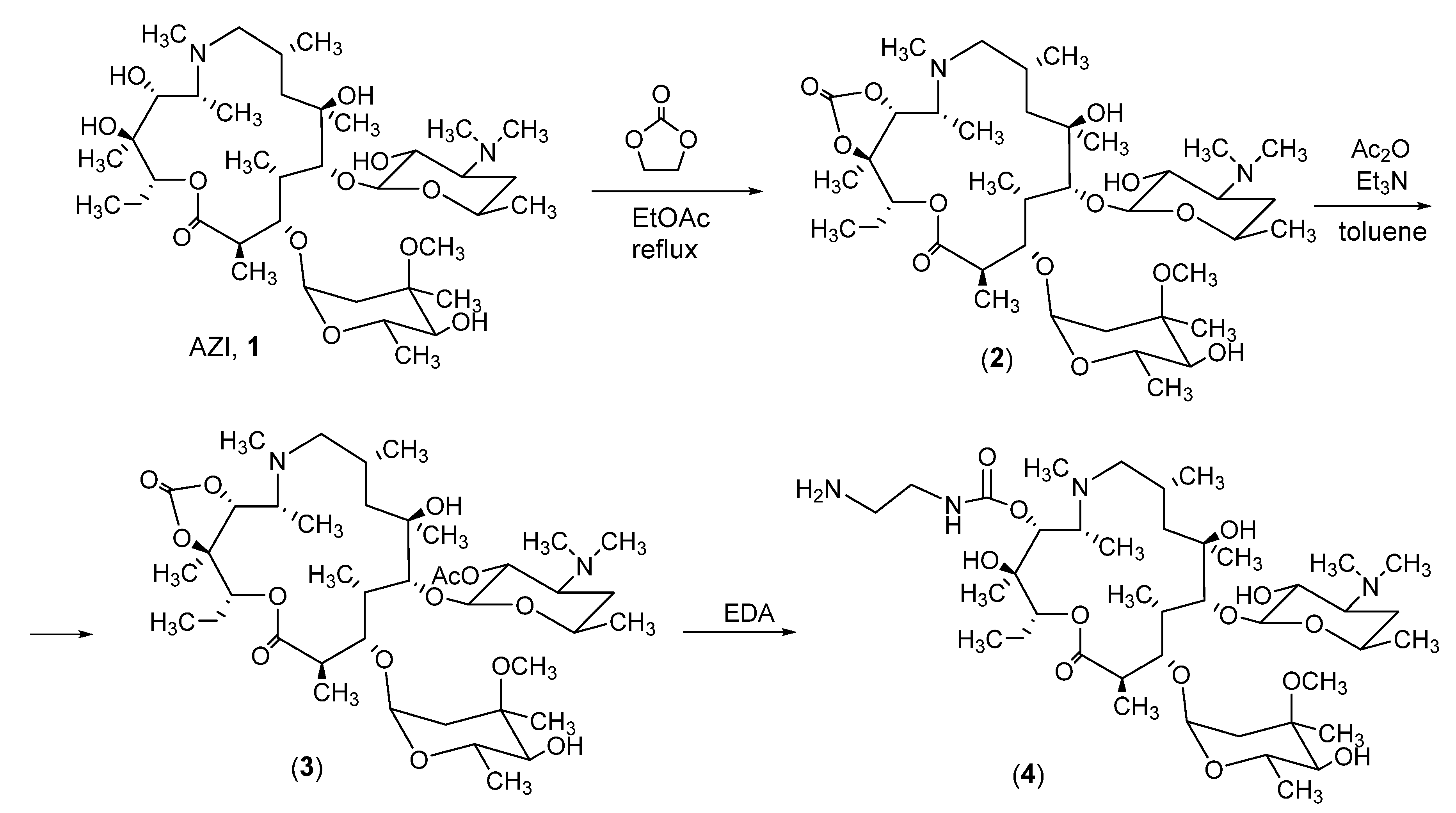
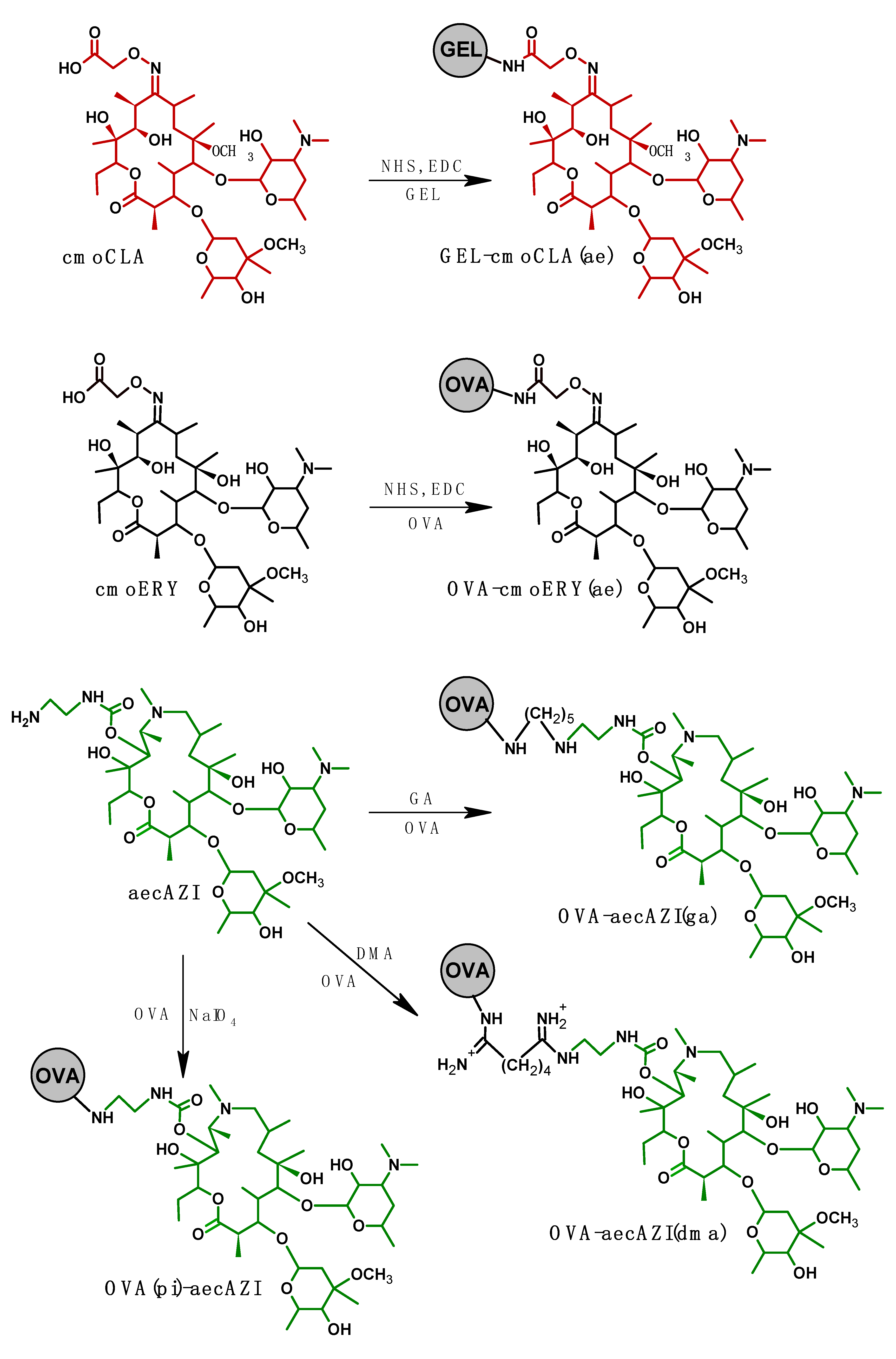
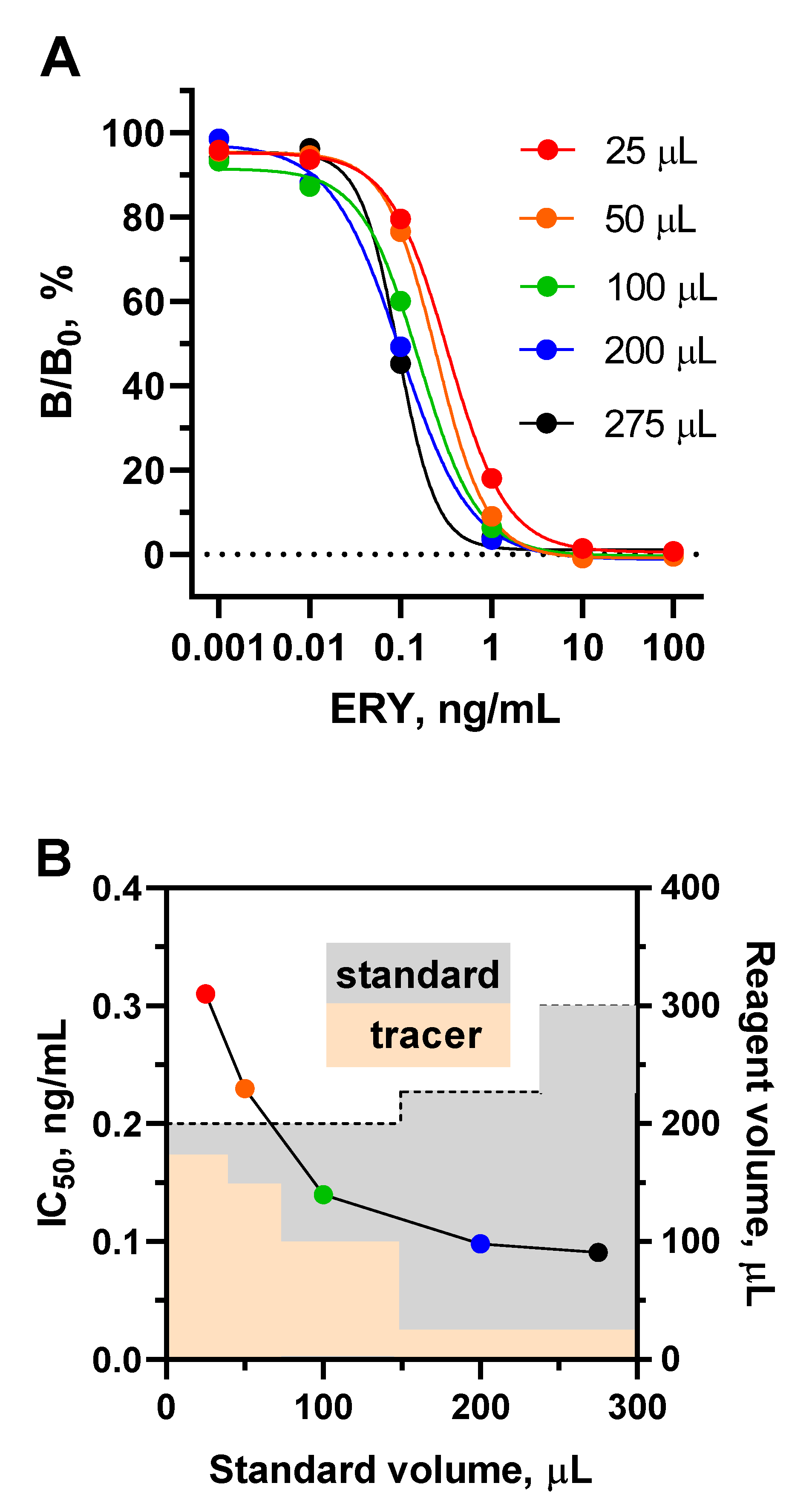
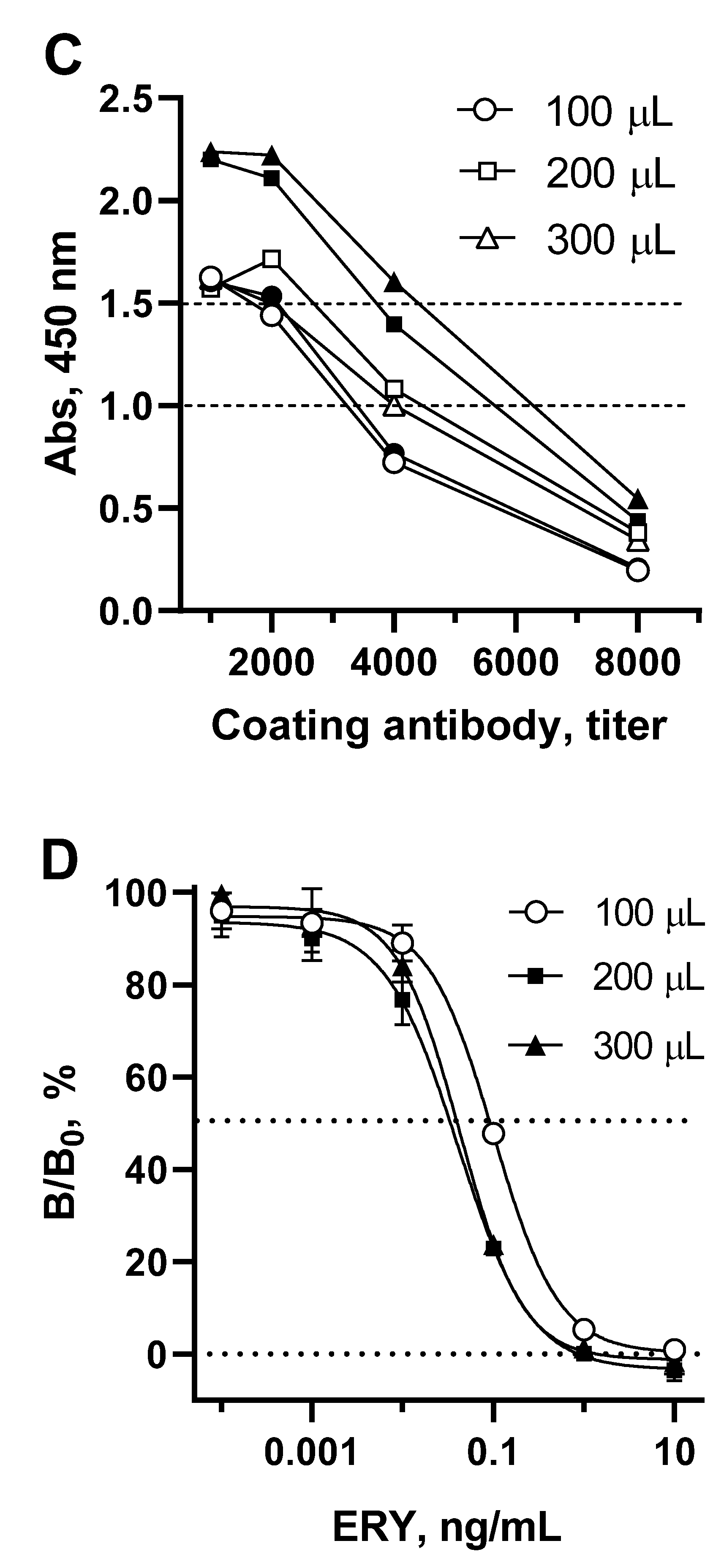
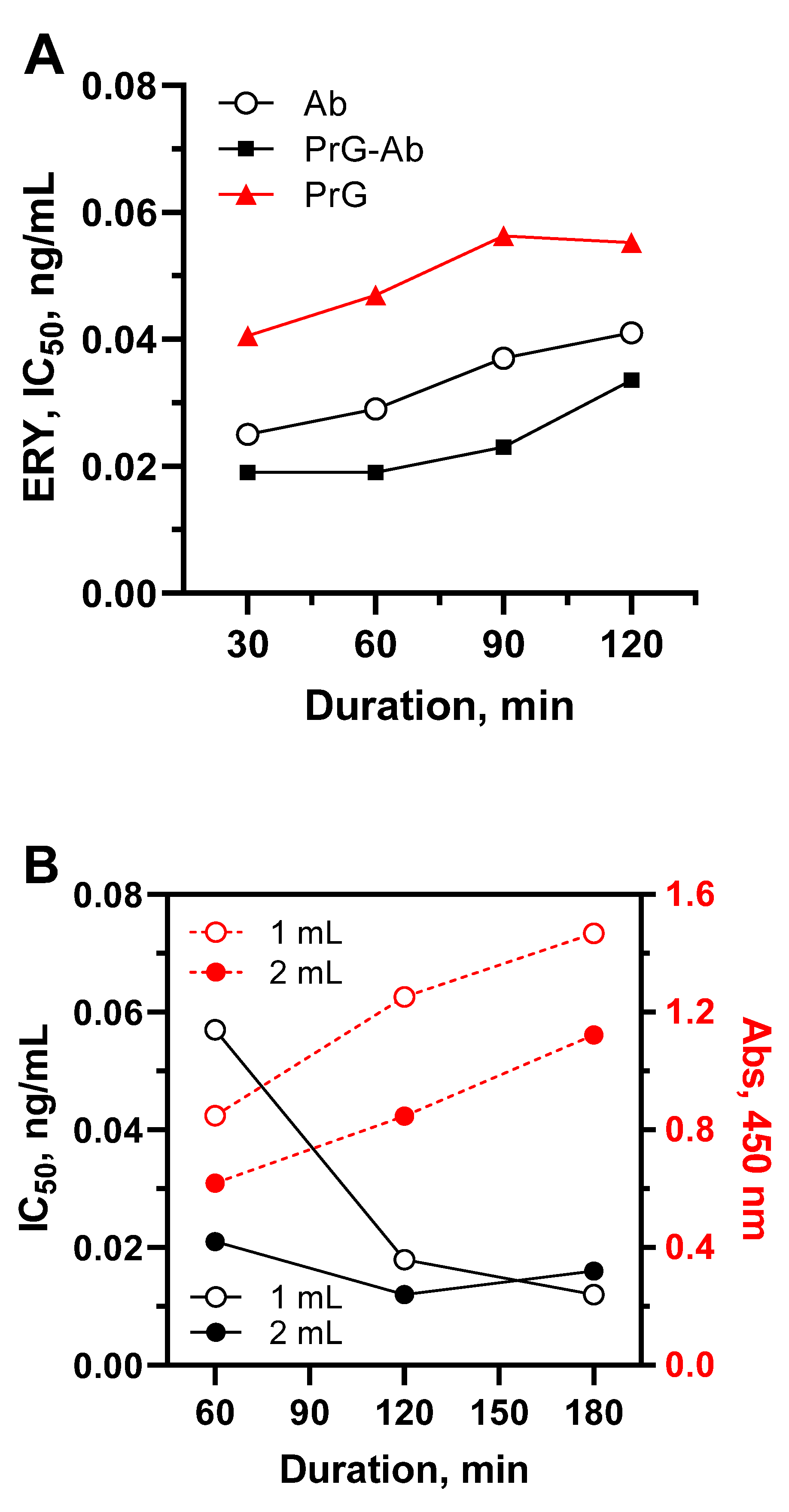
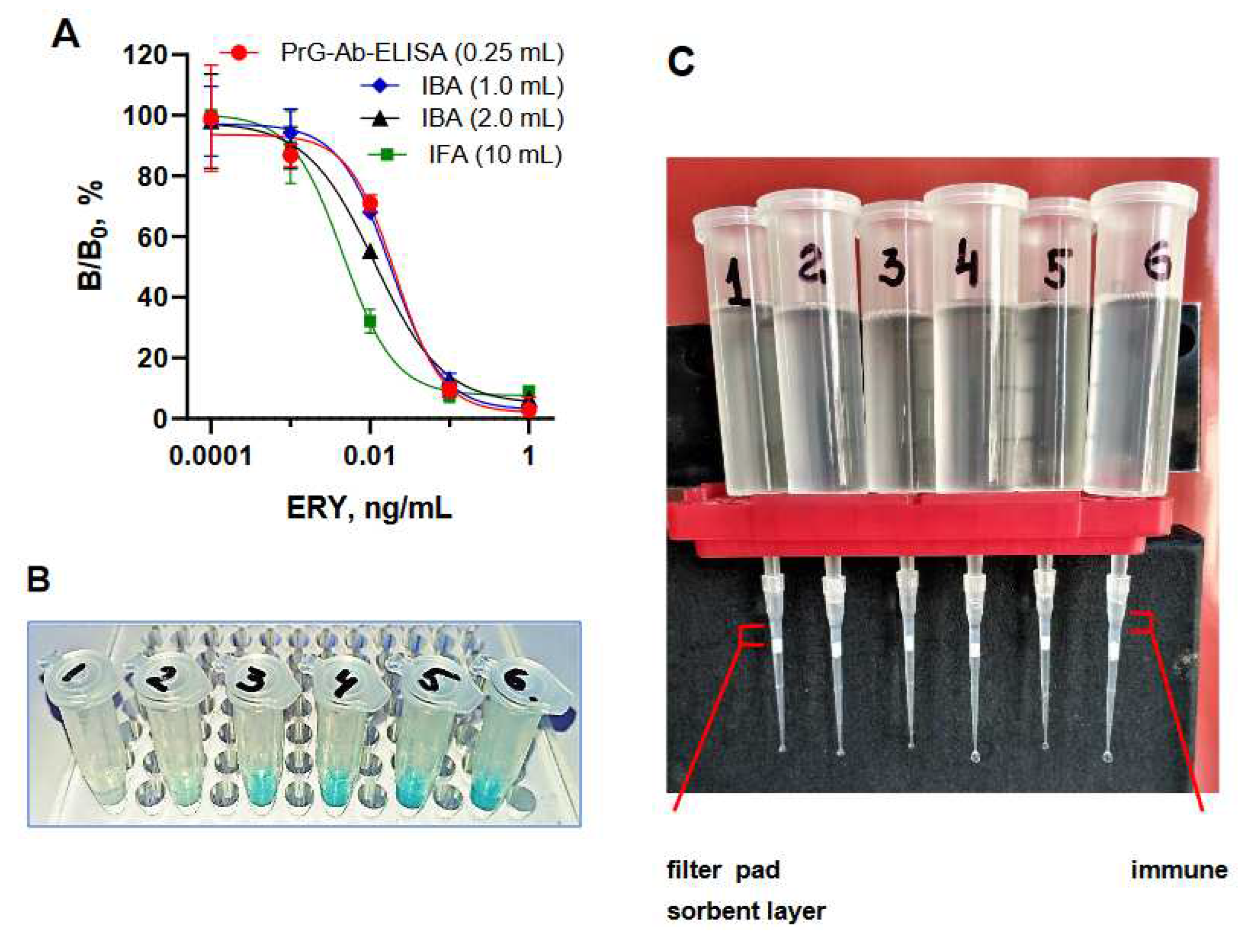
| MLs | GEL-cmoCLA(ae)* | OVA-cmoERY(ae) | OVA-aecAZI(ga) | OVA-aecAZI(dma) | OVA(pi)-aecAZI | |||||
|---|---|---|---|---|---|---|---|---|---|---|
| IC50, ng/mL | CR, % | IC50, ng/mL | CR, % | IC50, ng/mL | CR, % | IC50, ng/mL | CR, % | IC50, ng/mL | CR, % | |
| CLA | 0.16 | 100 | 0.172 | 100 | 0.043 | 100 | 0.157 | 100 | 0.044 | 100 |
| ERY | 0.20 | 68.2 | 0.240 | 71.7 | 0.049 | 87.8 | 0.223 | 70.4 | 0.042 | 105 |
| ESE | - | - | 0.466 | 36.9 | 0.094 | 45.7 | 0.352 | 44.6 | 0.074 | 59.5 |
| ROX | 0.14 | 125 | 0.125 | 137.6 | 0.040 | 107.5 | 0.157 | 100 | 0.051 | 86.3 |
| AZI | 1.63 | 8.8 | 1.990 | 8.6 | 0.315 | 13.7 | 1.220 | 12.9 | 0.107 | 41.1 |
| DIR | - | - | 0.554 | 31.0 | 0.136 | 31.6 | 0.544 | 28.9 | 0.096 | 45.8 |
| TUL | - | - | 629.9 | 2.7 | 134.8 | 0.03 | 379.5 | 0.04 | 5.403 | 0.81 |
| OLE | - | - | 75.75 | 0.2 | 40.10 | 0.11 | 287.2 | 0.05 | 45.64 | 0.1 |
| Assay (Matrix) | Immunogen | Antigen | IC50//LOD, ng/mL | CR, % | Reference | |
|---|---|---|---|---|---|---|
| ICA (Milk) | Commercial | Commercial | ni//5 | ERY | 100 | [32] |
| FM-ICA (Milk) | Commercial | Commercial | ni//0.13 | ERY | 100 | [33] |
| IC-ELISA (Milk) | BSA-cmoERY(ma) | OVA-cmoERY(ae) | 0.94//0.3 | CLA ERY ESE ROX AZI DIR |
26.7 100 - 14.8 0.9 157 |
[19] |
| ICA (Milk) | BSA-cmoCLA(ae) | OVA-cmoCLA(ae) | 0.16//0.095 | CLA ERY ESE ROX AZI DIR |
100 30.1 - 21.1 16.2 - |
[34] |
| LFIA (Breast milk) | BSA-cmoCLA(ae) | GEL-cmoCLA(ae) | 0.45//0.12 | CLA ERY ROX DIR AZI |
100 7.5 97.8 5.4 5.7 |
[20] |
| FPIA (Milk) | BSA-cmoERY(ma) | OVA-cmoERY(ae) | 7.4//14.1 | CLA ERY ESE ROX AZI DIR |
26.7 100 43.7 92 - 157 |
[35] |
| IC-ELISA (Water)IFA (Water) | BSA-cmoCLA(ae) | OVA(pi)-aecAZIHRP(pi)-aecAZI | 0.04//0.010.005//0.001 | CLA ERY ESE ROX AZI DIR |
100 105 59.5 86.3 41.1 45.8 |
Present study |
| Assay format, competitive step duration | Coating Ab volume, µL | Standard/Sample, µL | IC50, ng/mL | IC20-IC80, ng/mL | IC10, ng/mL |
|---|---|---|---|---|---|
| ELISA, 1h | 100 | 25 | 0.31 | 0.097-0.907 | 0.04 |
| 100 | 50 | 0.23 | 0.085-0.565 | 0.04 | |
| 100 | 100 | 0.14 | 0.037-0.400 | 0.008 | |
| 100 | 200 | 0.098 | 0.029-0.253 | 0.011 | |
| 100 | 275 | 0.091 | 0.043-0.184 | 0.024 | |
| 200 | 275 | 0.034 | 0.008-0.119 | 0.002 | |
| 300 | 275 | 0.040 | 0.012-0.119 | 0.006 | |
| PrG-ELISA, 1.5 h | 200 | 250 | 0.055 | 0.015-0.199 | 0.007 |
| PrG-Ab-ELISA, 0.5h | 200 | 250 | 0.020 | 0.006-0.054 | 0.002 |
| IBA, 2 h | 10 | 1000 | 0.018 | 0,006-0.056 | 0.003 |
| IBA, 2 h | 20 | 2000 | 0.012 | 0.003-0.057 | 0.001 |
| IFA, overnight | 50 | 10000 | 0.005 | 0.002-0.019 | 0.001 |
Disclaimer/Publisher’s Note: The statements, opinions and data contained in all publications are solely those of the individual author(s) and contributor(s) and not of MDPI and/or the editor(s). MDPI and/or the editor(s) disclaim responsibility for any injury to people or property resulting from any ideas, methods, instructions or products referred to in the content. |
© 2023 by the authors. Licensee MDPI, Basel, Switzerland. This article is an open access article distributed under the terms and conditions of the Creative Commons Attribution (CC BY) license (http://creativecommons.org/licenses/by/4.0/).





